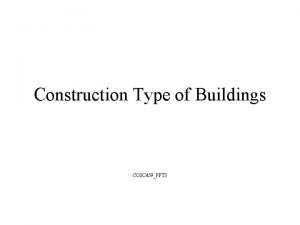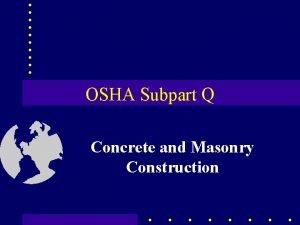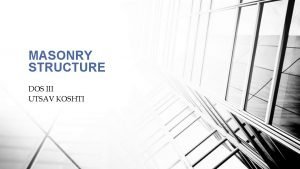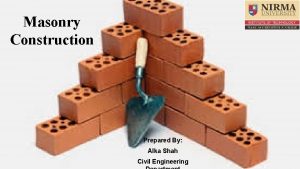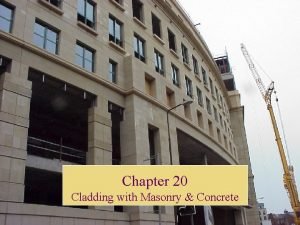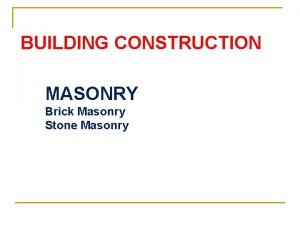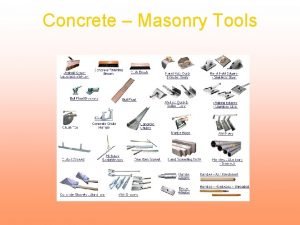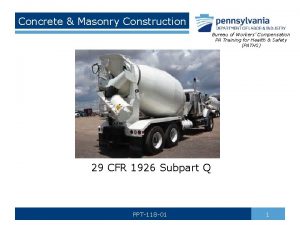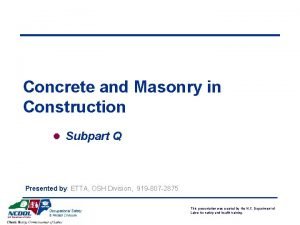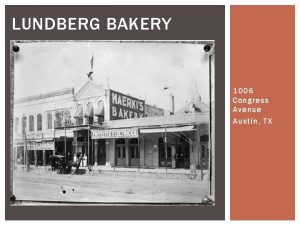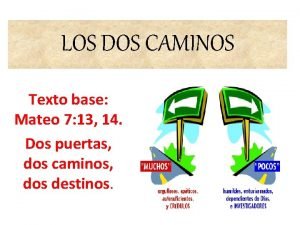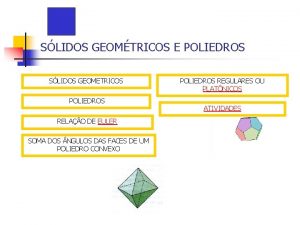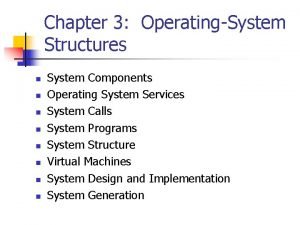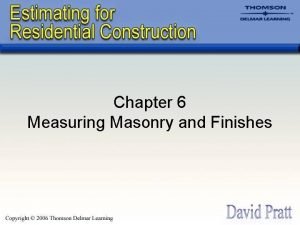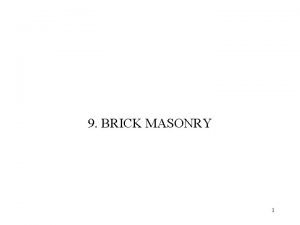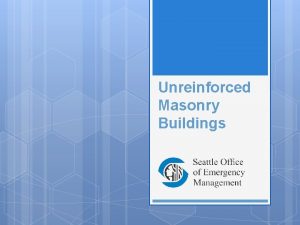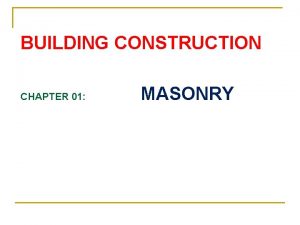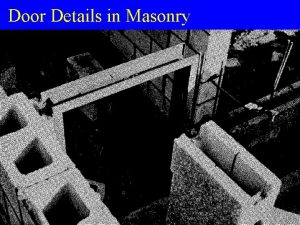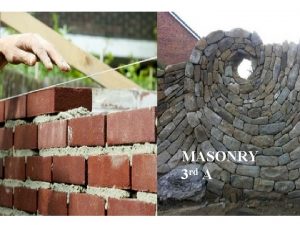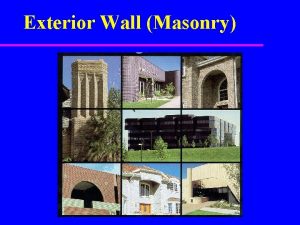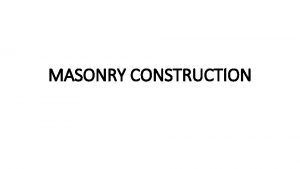MASONRY STRUCTURE DOS III UTSAV KOSHTI What is


































- Slides: 34

MASONRY STRUCTURE DOS III UTSAV KOSHTI

What is Masonry ? • Masonry is the building of structures from individual units laid in and bound together by mortar; the term masonry can also refer to the units themselves. • The common materials of masonry construction are brick, stone, marble, granite, limestone, cast stone, concrete block, glass block and tile. Masonry is generally a highly durable form of construction. However, the materials used, the quality of the mortar and workmanship, and the pattern in which the units are assembled can significantly affect the durability of the overall masonry construction.

Classification of Walls-structural context • Based on load bearing • Load bearing masonry walls. • Non-load bearing masonry walls. Ø Based on construction • Solid walls • Veneered walls • Reinforced walls • Cavity walls

Load bearing masonry walls • A load-bearing wall (or bearing wall) is a wall that bears a load resting upon it by conducting its weight to a foundation structure. • The materials most often used to construct load-bearing walls in large buildings are concrete, block, or brick.

Application Of Load Bearing Wall • Depending on the type of building and the number of stories, loadbearing walls are designed to the appropriate thickness to carry the weight above them. Without doing so, it is possible that an outer wall could become unstable if the load exceeds the strength of the material used, potentially leading to the collapse of the structure. § HOUSING § TALL BUILDINGS

Non-Load Bearing Wall • Walls that are only intended to support themselves and the weight of the cladding or sheathings attached. • Non load bearing walls provide no structural support and may be interior or exterior walls.

SOLID WALLS

SOLID WALLS • Masonry units laid close together with all joints filled solidly with mortar. Solid walls are structurally bonded by metal ties, masonry headers or by joint reinforcement. Where solid masonry walls are used, insulation and mechanical equipment are often installed within a furred space on the interior side of the wall. Below grade, insulation is often placed on the exterior side of the wall.

Insulation In Solid Walls • Slightly reduce the floor area of any rooms in which it is applied (the thickness of the insulation is around 100 mm) • Disruptive, but can be done room by room • Requires skirting boards, door frames and external fittings to be removed and reattached • Can make it hard to fix heavy items to inside walls – although special fixings are available • is generally cheaper to install than external wall insulation

External Wall Insulation

External Wall Insulation • Can be applied without interruption to the household • Does not reduce the floor area of your home • Renews the appearance of outer walls • Improves weatherproofing and sound resistance. • Fills cracks and gaps in the brickwork, which will reduce draughts • Increases the life of your walls by protecting the brickwork • Is best installed at the same time as external refurbishment work to reduce the cost • Is not recommended if the outer walls are structurally unsound and cannot be repaired.

Reinforced Masonry Walls

• Reinforced masonry is any type of brick, concrete or other type of masonry that is strengthened or fortified with the use of other building materials to increase resistance to deterioration due to weight bearing or other forms of stress • One of the most common examples of reinforced masonry involves exterior walls that are created using concrete blocks or clay bricks. Along with the blocks or bricks, steel rods are worked into the structure, often using some type of vertical framework that aids in allowing the walls to bear up under its own weight, and the weight of the connecting walls and floors within the building.

The weaknesses of the masonry without reinforcement: 1. the sensitivity to cracks 2. the low flexural bearing capacity Reinforcing in brickwork is applied for two causes: masonry is brittle material and is very sensitive to cracking. 3. Therefore, one part of the cracks can be prevented by using reinforcing bars or mesh embedded in the bed joint, or the size of cracks can be significantly decreased. 4. The flexural (tension) bearing capacity of masonry increases considerably with reinforcing.

Veneered Masonry Wall

Veneered Masonry Wall • A brick veneer wall is constructed by having a non-structural external layer, usually with bricks and it is backed by an air cavity. The innermost element of this type of wall is structural can consist of wood, metal framing or masonry. • A brick veneer construction has many advantages over solid masonry. It shares some of the advantages of a cavity wall. A brick veneer masonry wall is light weight, thermally efficient and can help in reducing costs.

Advantages • The airspace between the brick veneer wall and the structural element acts as a drainage system. • The cavity can be insulated and this improves thermal performance of the wall. • The structural element can be constructed first and this allows the rest of the construction to proceed. The brick veneer can be completed simultaneously. • A brick veneer construction takes less time to complete than a solid masonry wall which will give cost savings. • A veneer wall will weigh much less than a solid wall. Since the weight is less, the cost of the foundation and structural support can be reduced.


Some examples of brick veneered masonry walls.

CAVITY WALLS

Cavity Wall • The cavity wall method of construction was introduced in the northwest europe during the 19 th century and gained the widespread use from 1920’s. • In some early examples stones were used to tie the two leaves of the cavity walls together. Initially cavity widths were extremely narrow and were primarily implemented to prevent the passage of moisture into the interior of the building.

Cavity Wall • The cavity walls consist of two skins seperated by a hollow space (cavity). • The skins are commonly masonry such as brick or concrete block. Masonry is an absorbent material and therefore will slowly draw rainwater or even humidity into the wall. • The cavity serves as a way to drain this water back out through weep holes at the base of the wall system or above windows. • The reason cavity insulation keeps heat in is that the polymer and air in the cavity are good insulators.

Face wall • A wall in which facing and backing of two different materials are bonded together to ensure common action under load.

Curtain wall • A non-load bearing wall subject to lateral loads. It may be laterally supported by vertical or horizontal structural members, where necessary.

Column, Pier and Butress Column: An isolated vertical load bearing member, width of which does not exceed four times the thickness. Pier - A thickened. section forming integral part of a wall placed at intervals along the wall, to increase the stiffness of the wall or to carry a vertical concentrated load. Buttress-A pier of masonry built as an integral part of wall and projecting from either or both surfaces, decreasing in cross-sectional area from base to top.

Indian Standard for brick masonry • IS 1905: 1987 Code of practice for structural use of unreinforced masonry • IS 2212: 1962 Code of practice for brickwork • SP 20: Masonry Design and Construction.

IS 1905: 1987 Codal Provisions for Column Design • Table 1 Various Mix Proportion and strength of Mortar

IS 1905: 1987 Codal Provisions for Column Design • Table 4 Effective Height of Wall

IS 1905: 1987 Codal Provisions for Column Design • Table 5 Effective Length of Wall

IS 1905: 1987 Codal Provisions for Column Design • Effective Height of Column

IS 1905: 1987 Codal Provisions for Column Design Table 8 Basic Compressive Stress for Masonry

IS 1905: 1987 Codal Provisions for Column Design • Table 9 Compressive Stress Reduction: Factor takes into consideration the slenderness ratio of the element and also the eccentricity of loading.

IS 1905: 1987 Codal Provisions for Column Design Cl. 5. 4. 1. 2 Area reduction factor • This factor takes into consideration smallness of the sectional area of the element and is applicable when sectional area of the element is less than 0. 2 m 2. • The factor, ka = 0. 7 + 1. 5 A, A being the area of section in m 2.

IS 1905: 1987 Codal Provisions for Column Design Table 10 Shape Modification factor • This factor takes into consideration the shape of the unit, that is, height to width ratio ( as laid ) and is given in Table 10. This factor is applicable for units of crushing strength up to 15 N/mm%
 Utsav awasthi
Utsav awasthi Joisted masonry vs masonry non combustible
Joisted masonry vs masonry non combustible Hamlet act iii scene iii
Hamlet act iii scene iii String course in stone masonry
String course in stone masonry Osha part 1926 subpart cc
Osha part 1926 subpart cc A limited access zone must
A limited access zone must What is masonry
What is masonry Joggle joint in stone masonry
Joggle joint in stone masonry European masonry
European masonry Masonry veneer curtain walls:
Masonry veneer curtain walls: Throating in stone masonry
Throating in stone masonry Squint junction in brick masonry
Squint junction in brick masonry Common float in masonry
Common float in masonry Double flemish bond and single flemish bond
Double flemish bond and single flemish bond As 4773 masonry in small buildings
As 4773 masonry in small buildings Barry cargill masonry
Barry cargill masonry Masonry saw shall be guarded with a
Masonry saw shall be guarded with a Employers must not place construction loads
Employers must not place construction loads Dry masonry
Dry masonry Lundberg masonry
Lundberg masonry Cmaa masonry
Cmaa masonry A masonry dam of trapezoidal cross section
A masonry dam of trapezoidal cross section Hallar la distancia
Hallar la distancia Los dos reyes y dos laberintos
Los dos reyes y dos laberintos Defesa dos direitos dos usuários pnh
Defesa dos direitos dos usuários pnh El que habla dos idiomas vale por dos
El que habla dos idiomas vale por dos La biblia habla de dos caminos
La biblia habla de dos caminos Los envió de dos en dos
Los envió de dos en dos Poliedro
Poliedro Faces laterais
Faces laterais Ms dos layer structure
Ms dos layer structure Manuale wppsi pdf
Manuale wppsi pdf What is a class iii laser
What is a class iii laser Tłumacz
Tłumacz Potop szwedzki tomaszewska
Potop szwedzki tomaszewska

